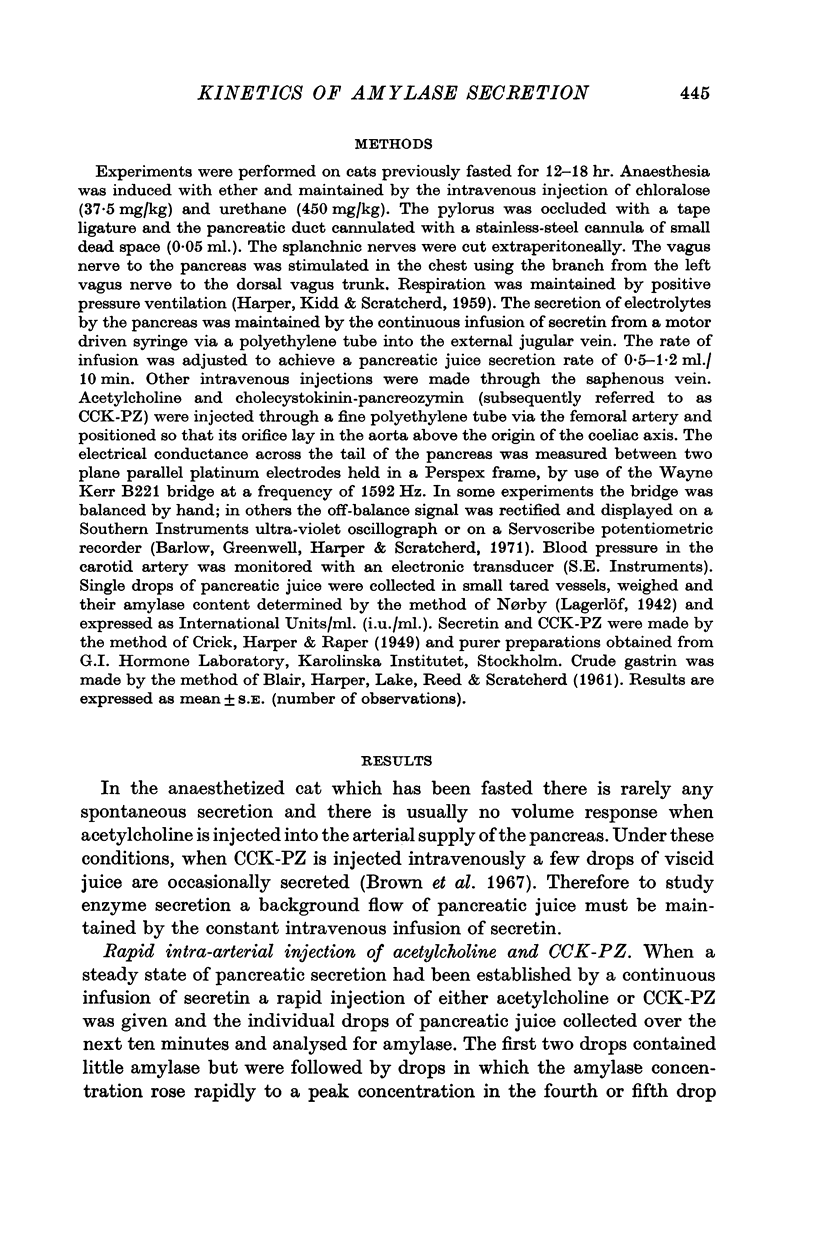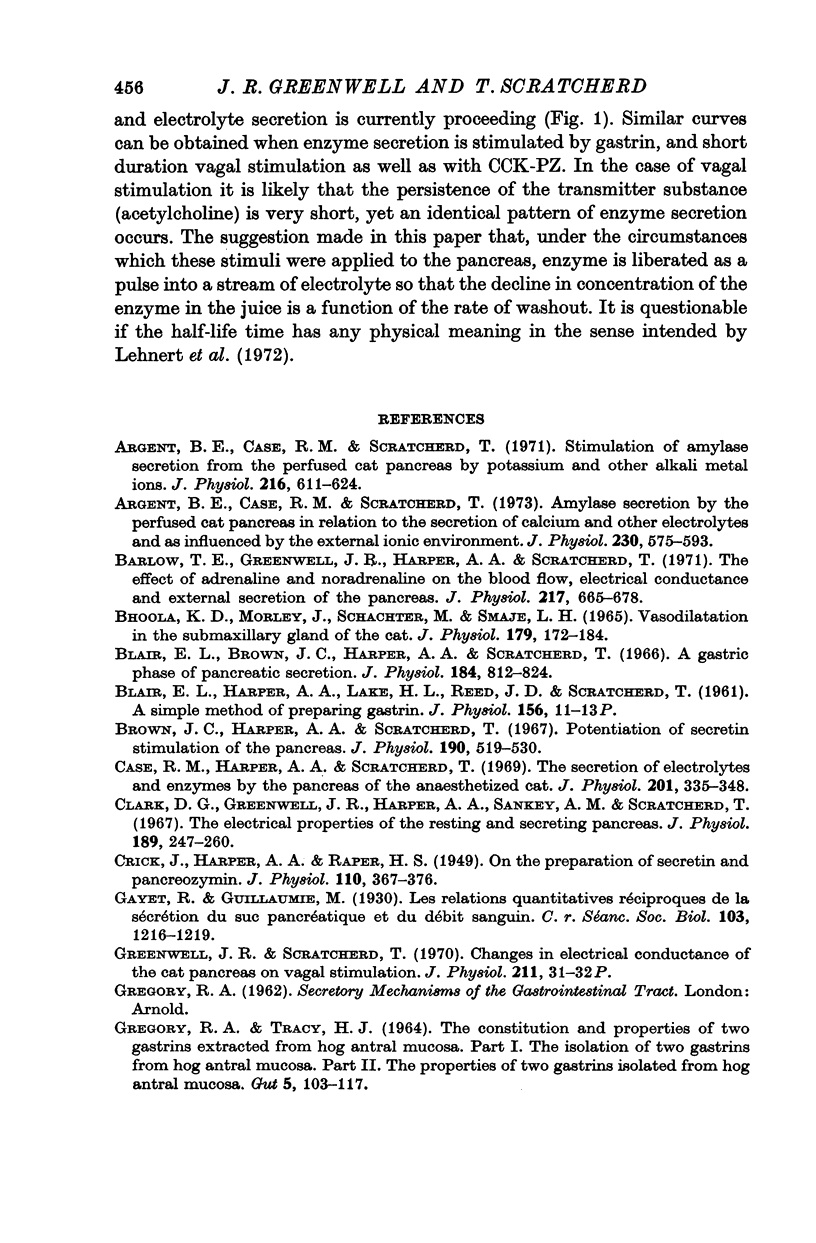Abstract
1. Enzyme secretion in response to short duration vagal stimulation or to rapid I.V. injections of cholecystokinin-pancreozymin (CCK-PZ) or gastrin or to intra-arterial injections of acetylcholine is a function of the volume of juice secreted and not primarily a function of time.
2. The output of amylase in response to each stimulus occurred in a constant volume of approximately 15 drops (0·5 ml.) regardless of the rate of background secretin stimulated flow of water and electrolyte.
3. It is argued that because amylase secretion occurs in this constant volume, it is due to the rapid secretion of enzyme into the duct system from the acini, and subsequently the secretin stimulated secretion of water and bicarbonate washes the enzyme from the duct system.
4. When enzyme secretion is stimulated an increase in the electrical conductance (measured at 1·592 kHz) occurs across the tail of the pancreas. This increased conductance has two components. An early peak associated with the extrusion of enzyme from the acinar cell and a later peak which is probably due to vasodilatation.
5. Atropine was without effect on both enzyme secretion and the conductance record when the stimulant was CCK-PZ.
Atropine blocked enzyme secretion and both peaks of the conductance record in response to stimulation by acetylcholine.
Atropine blocked enzyme secretion and abolished the early phase of the conductance record, on vagal stimulation. It was without effect on the later peak which probably indicates an atropine resistant vasodilation of the pancreatic vessels.
6. When the vagus is stimulated on a background of submaximal electrolyte secretion caused by the intravenous infusion of secretin, the volume rate of secretion and the rate of amylase secretion follow a similar time course. The maximal volume response occurred between 7 Hz and 15 Hz and the maximal amylase output per impulse was at 5 Hz.
Full text
PDF














Selected References
These references are in PubMed. This may not be the complete list of references from this article.
- Argent B. E., Case R. M., Scratcherd T. Amylase secretion by the perfused cat pancreas in relation to the secretion of calcium and other electrolytes and as influenced by the external ionic environment. J Physiol. 1973 May;230(3):575–593. doi: 10.1113/jphysiol.1973.sp010205. [DOI] [PMC free article] [PubMed] [Google Scholar]
- Argent B. E., Case R. M., Scratcherd T. Stimulation of amylase secretion from the perfused cat pancreas by potassium and other alkali metal ions. J Physiol. 1971 Aug;216(3):611–624. doi: 10.1113/jphysiol.1971.sp009543. [DOI] [PMC free article] [PubMed] [Google Scholar]
- Barlow T. E., Greenwell J. R., Harper A. A., Scratcherd T. The effect of adrenaline and noradrenaline on the blood flow, electrical conductance and external secretion of the pancreas. J Physiol. 1971 Sep;217(3):665–678. doi: 10.1113/jphysiol.1971.sp009592. [DOI] [PMC free article] [PubMed] [Google Scholar]
- Bhoola K. D., Morley J., Schachter M., Smaje L. H. Vasodilatation in the submaxillary gland of the cat. J Physiol. 1965 Jul;179(1):172–184. doi: 10.1113/jphysiol.1965.sp007656. [DOI] [PMC free article] [PubMed] [Google Scholar]
- Blair E. L., Brown J. C., Harper A. A., Scratcherd T. A gastric phase of pancreatic secretion. J Physiol. 1966 Jun;184(4):812–824. doi: 10.1113/jphysiol.1966.sp007949. [DOI] [PMC free article] [PubMed] [Google Scholar]
- Brown J. C., Harper A. A., Scratcherd T. Potentiation of secretin stimulation of the pancreas. J Physiol. 1967 Jun;190(3):519–530. doi: 10.1113/jphysiol.1967.sp008225. [DOI] [PMC free article] [PubMed] [Google Scholar]
- CRICK J., HARPER A. A., RAPER H. S. On the preparation of secretin and pancreozymin. J Physiol. 1949 Dec;110(3-4):367–376. doi: 10.1113/jphysiol.1949.sp004445. [DOI] [PMC free article] [PubMed] [Google Scholar]
- Case R. M., Harper A. A., Scratcherd T. The secretion of electrolytes and enzymes by the pancreas of the anaesthetized cat. J Physiol. 1969 Apr;201(2):335–348. doi: 10.1113/jphysiol.1969.sp008759. [DOI] [PMC free article] [PubMed] [Google Scholar]
- Clark D. G., Greenwell J. R., Harper A. A., Sankey A. M., Scratcherd T. The electrical properties of resting and secreting pancreas. J Physiol. 1967 Apr;189(2):247–260. doi: 10.1113/jphysiol.1967.sp008166. [DOI] [PMC free article] [PubMed] [Google Scholar]
- GREGORY R. A., TRACY H. J. THE CONSTITUTION AND PROPERTIES OF TWO GASTRINS EXTRACTED FROM HOG ANTRAL MUCOSA. Gut. 1964 Apr;5:103–114. [PMC free article] [PubMed] [Google Scholar]
- HARPER A. A., KIDD C., SCRATCHERD T. Vago-vagal reflex effects on gastric and pancreatic secretion and gastrointestinal motility. J Physiol. 1959 Oct;148:417–436. doi: 10.1113/jphysiol.1959.sp006297. [DOI] [PMC free article] [PubMed] [Google Scholar]
- Harper A. A., Raper H. S. Pancreozymin, a stimulant of the secretion of pancreatic enzymes in extracts of the small intestine. J Physiol. 1943 Jun 30;102(1):115–125. doi: 10.1113/jphysiol.1943.sp004021. [DOI] [PMC free article] [PubMed] [Google Scholar]
- Harper A. A., Vass C. C. The control of the external secretion of the pancreas in cats. J Physiol. 1941 Jun 30;99(4):415–435. doi: 10.1113/jphysiol.1941.sp003912. [DOI] [PMC free article] [PubMed] [Google Scholar]
- Hilton S. M., Jones M. The role of plasma kinin in functional vasodilatation in the pancreas. J Physiol. 1968 Apr;195(3):521–533. doi: 10.1113/jphysiol.1968.sp008472. [DOI] [PMC free article] [PubMed] [Google Scholar]
- Korovitsky L. K. The part played by the ducts in the pancreatic secretion. J Physiol. 1923 Mar 21;57(3-4):215–223. doi: 10.1113/jphysiol.1923.sp002060. [DOI] [PMC free article] [PubMed] [Google Scholar]
- Lehnert P., Stahlheber H., Forell M. M., Fritz H., Werle E. Kinetics of exocrine pancreatic secretion. Digestion. 1972;6(1):9–22. doi: 10.1159/000197218. [DOI] [PubMed] [Google Scholar]
- Lenninger S., Ohlin P. The flow of juice from the pancreatic gland of the cat in response to vagal stimulation. J Physiol. 1971 Jul;216(2):303–318. doi: 10.1113/jphysiol.1971.sp009526. [DOI] [PMC free article] [PubMed] [Google Scholar]


